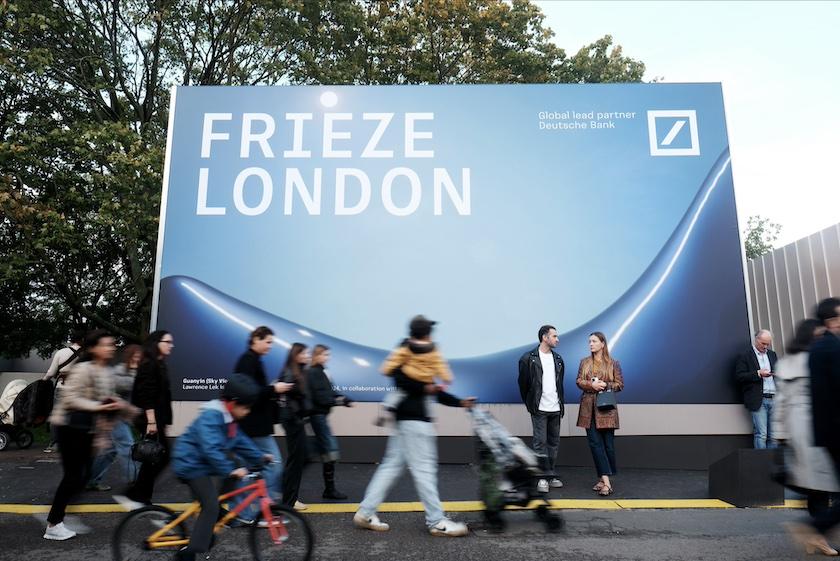
Frieze London 2024.
Returning to magnificent Regent’s Park in the heart of London, the 2024 editions of Frieze London and Frieze Masters brought together over 270 galleries from 43 countries and attracted 90,000 visitors from over 110 nations worldwide. With a strong presence of major international collectors, institutions, and art enthusiasts, galleries reported major sales throughout the fairs’ five-day run.
“It’s been an extraordinary week, marked by continued sales and a vibrant international presence on every day,” Eva Langret, Director of Frieze London, shared with Art & Object. “The fair has attracted growing interest from a diverse range of collectors, both established and emerging, which is immensely encouraging.”
Nathan Clements-Gillespie, Director of Frieze Masters, added, “Frieze Masters continues to deliver unparalleled opportunities for collectors and curators, cementing its position as a must-attend event in the global art calendar. This year, we witnessed exceptionally strong demand for works spanning all eras, from classical art to 20th century masterpieces, with major sales reported throughout the week. Our exhibitors truly brought their finest works, and were rewarded for it with resounding success.”
Delving into the latest contemporary art at Frieze London and viewing Frieze Masters to survey centuries-old art alongside more recently created works, Art & Object has compiled a curated list of the best booths at the fairs.
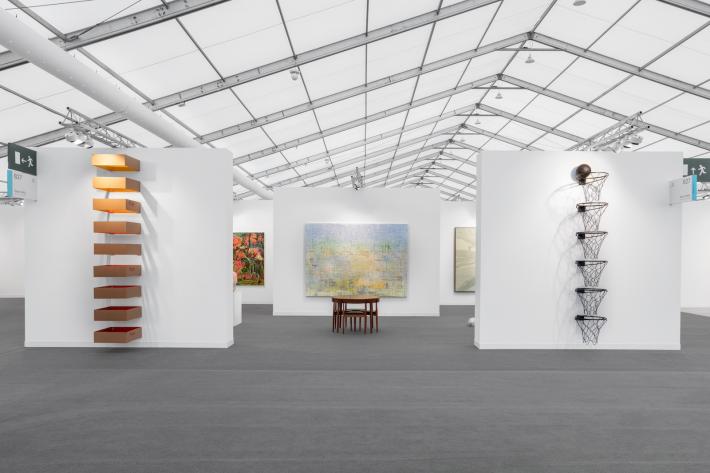
Presenting a selection of works in a variety of media by gallery artists, including a pair of abstracted quartz crystal shoes, titled Shoes for Departure, that Marina Abramović made after her 1988 Great Wall of China walk, and a painting from Laurent Grasso’s Studies into the Past series paying homage to the impressionist Claude Monet in its depiction of London’s Houses of Parliament while referencing his film Soleil Double (Double Sun), Sean Kelly’s booth was the first to catch our eye.
We were immediately drawn to the pairing of Jose Dávila’s low-tech, cardboard interpretation of Donald Judd’s celebrated stacked metal boxes and Awol Erizku’s stacked basketball hoops with a ball about to enter, referencing both Judd’s Stacks and Jay-Z’s lyrics from Picasso Baby, “Oh, what a feeling, Fuck it, I want a Billion,” which is the appropriated title of Erizku’s witty work.
Image: Installation View. Sean Kelly, Frieze London.
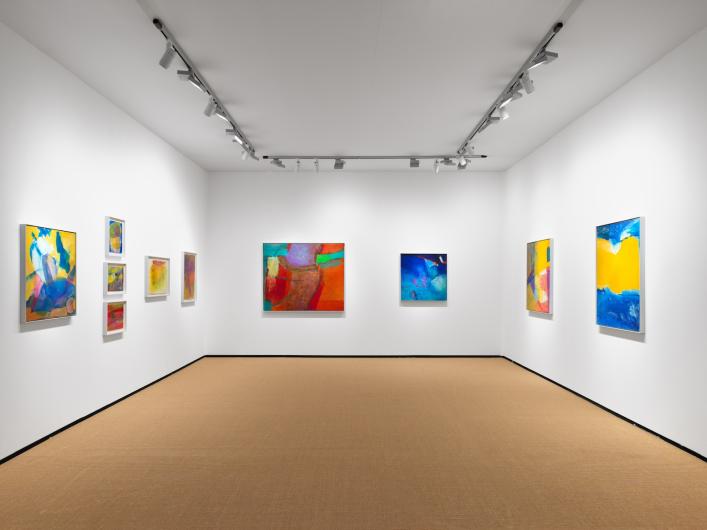
Energizing its booth with vibrant color, Miles McEnery Gallery presented a solo show of paintings and works on paper from 1962 to 2008 by the American abstract painter Emily Mason. The daughter of Alice Trumbull Mason, a founding member of the American Abstract Artists, and the wife of Wolf Kahn, a German-born American painter who combined Realism with Color Field painting, Mason emerged on the 10th Street gallery scene in 1960 and exhibited regularly in museums and galleries across America until her death in 2019.
Layering transparent washes of brightly colored oils in most paintings on view, and oils mixed with expressive marks of pastels in others, Mason worked directly on the canvas or paper, defining spatial relationships while letting the paintings guide her hand, eye, and mind until their sublime completion.
Image: Installation View, Miles McEnery Gallery, Frieze Masters.
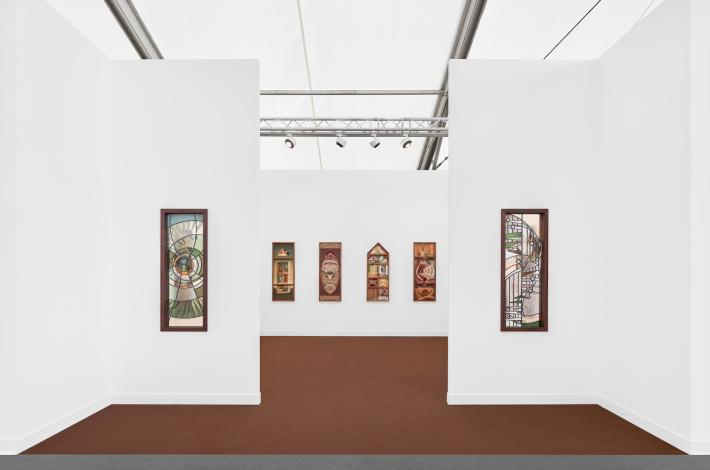
Fronted by two of the artist’s stained glass windows of winding staircases and spiraling spaces, Charlotte Edey’s vertical mixed-media paintings transformed Ginny on Frederick’s booth into a chapel-like realm. Juxtaposing small paintings, skillful embroidery, and intimately beaded pictures of surreal architectural spaces divided into sections by beautifully crafted wood paneled frames, the young British artist’s poetic pieces present psychological scenarios in a vast array of natural materials. Like M.C. Escher or Rene Magritte, her dreamy architectural scenes invite the eye while impacting the mind.
Image: Installation View, Ginny on Frederick, Frieze London.
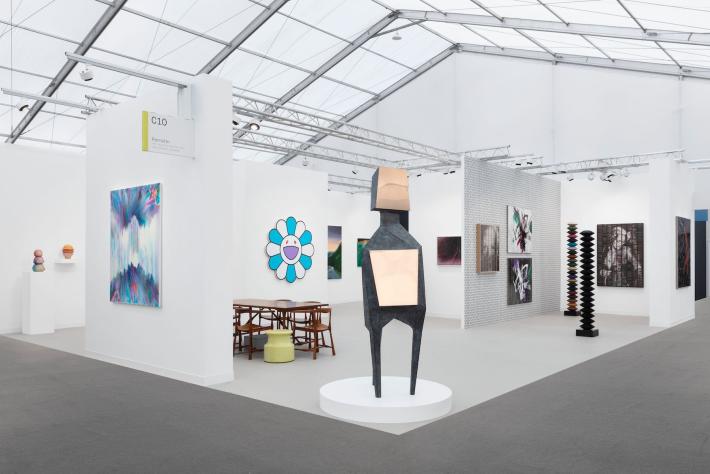
Presenting an overview of its strong stable of artists, including a striking bronze sculpture by Lynn Chadwick, whose estate the gallery recently began representing, Perrotin highlighted three artists with solo exhibitions within the booth: Gregor Hildebrandt, Kathia St. Hilaire, and Otani Workshop. With portraits of film stars like Marlene Dietrich melded into plastic cassette tape cases, abstract paintings rendered on combined strips of audiotape, and totemic columns constructed from re-shaped vinyl records, Hildebrandt mines music and movies for new possibilities as art.
Kathia St. Hilaire, meanwhile, tapped into her Caribbean roots to create ornate, shaped, figurative paintings inspired by Spiralism, an artistic movement founded in Haiti in the 1960s, and Otani Workshop offered a dreamlike alcove with sculptures and paintings of creatures and kids.
Image: Installation View, Gregor Hildebrandt, Perrotin, Frieze London.
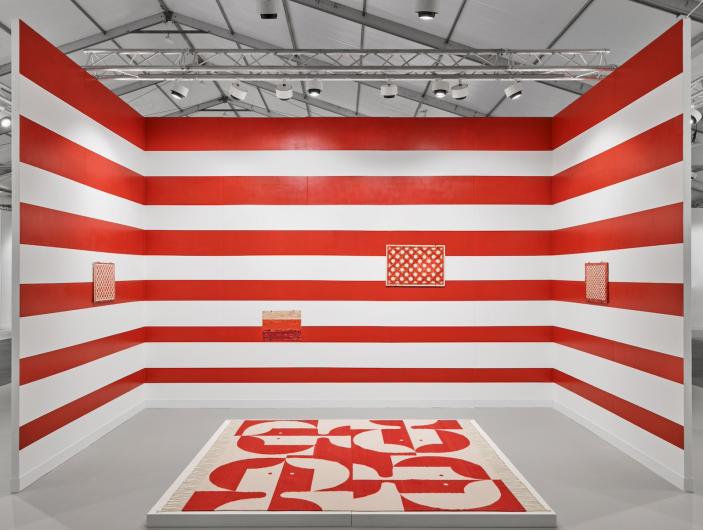
With a booth presenting finely crafted pieces by Tacita Dean, Cornelia Parker, Thomas Schütte, Nancy Spero, and Juan Uslé, Frith Street Gallery carved out a separate show space for a solo presentation of new ceramic and textile works by Polly Apfelbaum. Readying the rectangular space with red and white stripes on the walls, the artist displayed an arresting red and white hand-made carpet featuring the repeated head of a stylized woman with a bob hairstyle on the floor and ceramic paintings on the striped walls.
While the rug referenced an illustration from a 1963 patronizing book about a woman’s potential in future societies, several of her more abstract glazed terracotta pieces were inspired by a motif from an American Folk Art Museum exhibition catalogue for a 2011 show on red and white quilts.
Image: Installation View, Polly Apfelbaum, Frith Street Galllery, Frieze London.
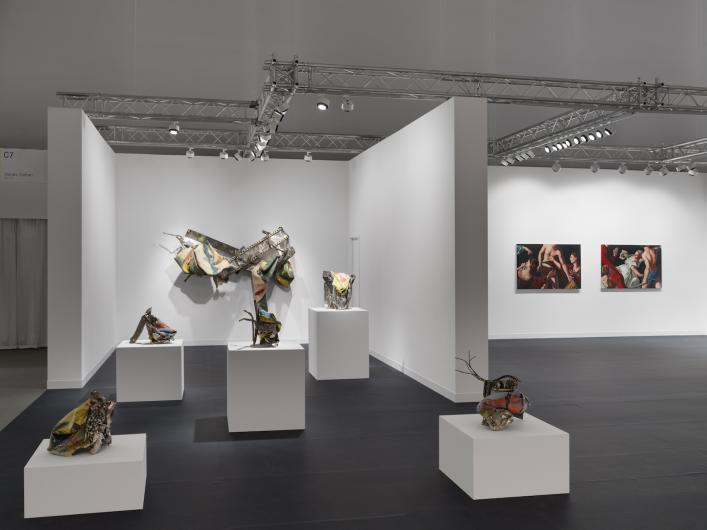
James Cohan’s two-person booth, featuring Jesse Mockrin and Kennedy Yanko's new work, divided the exhibition into two distinctive rooms for two compelling, yet completely different, women artists. Exploring biblical and classical narratives in singular and multi-panel paintings and drawings, Mockrin realistically revises such age-old narratives as the Abduction of the Sabine Women, the Judgement of Solomon, and Susannah and the Elders while exposing the exploitation of the weaknesses of women in these tales to upend them.
In contrast, Yanko works with painted skins and found metal to construct sublime sculptures and architecturally scaled installations inspired by Abstract Expressionism and Color Field painting. For Frieze London, she reduced the scale of her paintings/sculptures to create a stunning series of miniatures.
Image: Installation View, Kennedy Yanko and Jesse Mockrin, James Cohan, Frieze London.
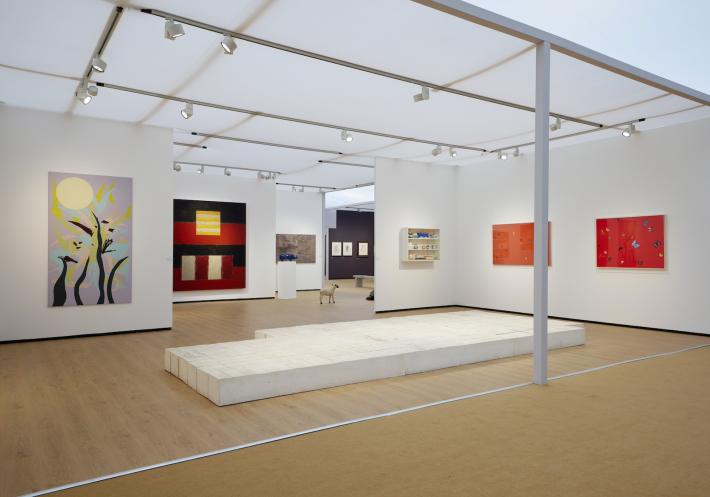
In an excellently curated presentation titled Icons of the British Art Scene: From the Young British Artists to Established Masters, the gallery featured seminal works by YBA artists Damien Hirst, Gavin Turk, and Gary Hume that surrounded an impressive cast-floor sculptural installation by Rachel Whiteread in half of its booth and significant works by Frank Auerbach, Alighiero Boetti, Alexander Calder, Lucio Fontana, François-Xavier Lalanne, and Sean Scully in the other section.
The show's centerpiece, Whiteread’s Untitled (Floor), initially created for Documenta IX in 1992, was cast from the cavity beneath the floor of the famous Fredericianum in Kassel— making a three-dimensional memory of the space. In a corner of the booth, the gallery offered a selection of small mobiles and colorful abstract paintings by Calder, who is also the subject of an excellent solo show at its London space.
Image: Installation View, Ben Brown Fine Arts, Frieze Masters.
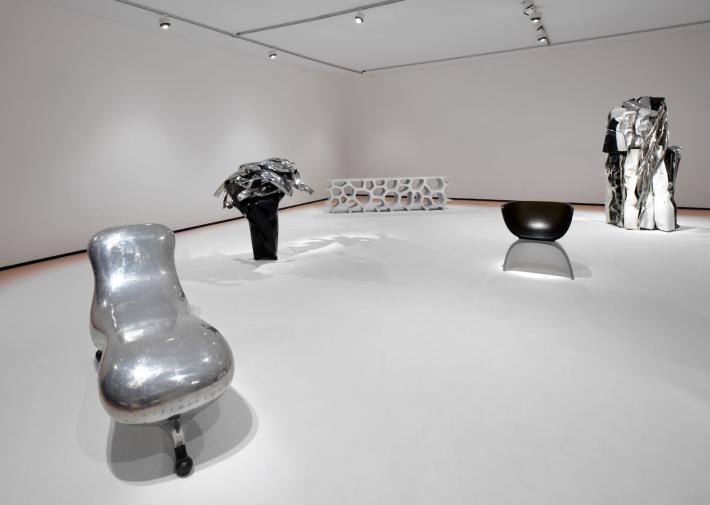
In an almost all-white booth that looked like a stylish showroom, superstar artist Urs Fischer paid homage to two of his favorite artists and designers by pairing abstract sculptural works from 2008 to 2011 by John Chamberlain with avant-garde furniture designs from 1988 to 2017 by Marc Newsom. Fischer’s finely curated presentation featured Chamberlain’s signature crushed car part sculptures, with the three pieces on view mixing twisted chrome bumpers mashed up with painted body parts.
His choice of Newsom pieces included: the Australian designer’s surreally shaped Lockheed Lounge, which has a polyester resin core and a dynamic riveted aluminum surface; his cast glass and nickel chairs; and a carved white Carrara marble shelf. Fischer, who has a fantastic London show of new mixed-media paintings at Sadie Coles HQ, also designed a printed tufted carpet for the booth, further unifying the installation.
Image: Installation View, John Chamberlain and Marc Newson, Gagosian. Artwork © Marc Newson, © 2024 Fairweather & Fairweather LTD/Artists Rights Society (ARS), New York.

Highlighting coveted contemporary Italian artists, Mazzoleni featured an abstract calligraphic canvas by Carla Accardi, hyper-saturated imaginary landscapes and cityscapes by Salvo, and punctured and slashed brass spherical sculptures by Lucio Fontana.
However, the main attraction at the booth was the clever contrast of a metaphysical masterpiece of surreal figures in a town square by Giorgio de Chirico with Andy Warhol’s later painting that appropriated and repeated the former’s enchanting canvas. Presented opposite one another in the gallery’s Frieze Master’s spectacular installation, the pairing showed how each generation of fine artists influences the next.
Image: Installation View, Mazzoleni, Frieze Masters.
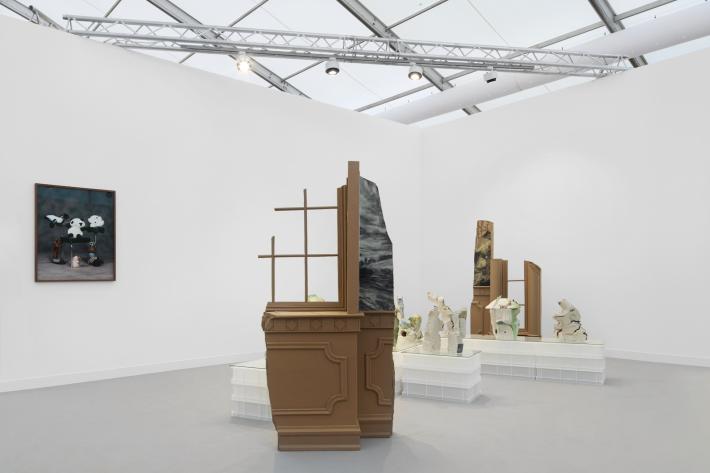
Winner of the Focus Stand Prize at Frieze London 2024, the London and Athens-based gallery Hot Wheels was awarded the prize for its solo presentation by New York art/fashion collective CFGNY. Founded in 2016 and composed of Daniel Chew, Ten Izu, Kirsten Kilponen and Tin Nguyen, CFGNY (Concept Foreign Garments New York) works across fashion, video, performance, installation, and sculpture, exploring the experience of ‘global Asianness’.
For the gallery’s booth in Focus, a section dedicated to fostering a community of young galleries, CFGNY created architectural details from cardboard– a material synonymous with trade and the disposable– and abstract sculptures in porcelain, an Asian luxury good that was vehemently counterfeited in Europe, to reveal the complex position of Asia within a global network that often excludes it as both a place and an idea.
Image: Installation View, HotWheels, Frieze London.
Paul Laster
Paul Laster is a writer, editor, curator, advisor, artist, and lecturer. New York Desk Editor for ArtAsiaPacific, Laster is also a Contributing Editor at Raw Vision and Whitehot Magazine of Contemporary Art and a contributing writer for Art & Object, Ocula, Galerie, Artsy, Sculpture, Time Out New York, Conceptual Fine Arts, and Two Coats of Paint. Formerly the Founding Editor of Artkrush, he began The Daily Beast’s art section and was Art Editor at Russell Simmons’ OneWorld Magazine. Laster has also been the Curatorial Advisor for Intersect Art & Design and an Adjunct Curator at P.S.1 Contemporary Art Center, now MoMA PS1.























